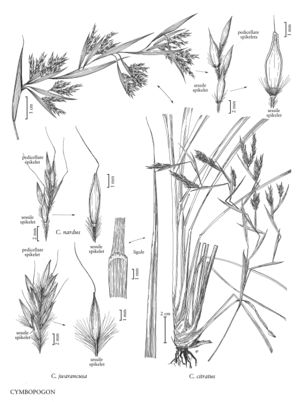Difference between revisions of "Cymbopogon jwarancusa"
FNA>Volume Importer |
FNA>Volume Importer |
||
| Line 38: | Line 38: | ||
|publication year= | |publication year= | ||
|special status= | |special status= | ||
| − | |source xml=https://jpend@bitbucket.org/aafc-mbb/fna-data-curation.git/src/ | + | |source xml=https://jpend@bitbucket.org/aafc-mbb/fna-data-curation.git/src/f6b125a955440c0872999024f038d74684f65921/coarse_grained_fna_xml/V25/V25_1601.xml |
|subfamily=Poaceae subfam. Panicoideae | |subfamily=Poaceae subfam. Panicoideae | ||
|tribe=Poaceae tribe Andropogoneae | |tribe=Poaceae tribe Andropogoneae | ||
Revision as of 19:23, 24 September 2019
Plants perennial. Culms to 150 cm, erect or geniculate; nodes often swollen. Basal sheaths glabrous, smooth, whitish-green; ligules 2-6 mm, truncate to acute; blades to 30 cm long, 1.5-4 mm wide, whitish. Inflorescences 15-40 cm, erect; rames 1322 mm; internodes and pedicels densely pilose on the margins and dorsal surface. Sessile spikelets of heterogamous pairs 4.5-5.5 mm; lower glumes lanceolate, shallowly concave distally, sharply keeled, keels not winged; upper lemmas awned, awns 7-10 mm. Pedicellate spikelets about 6 mm. 2n = 20.
Discussion
Cymbopogon jwarancusa is native to Asia, where it is grown for perfume and as a medicine for fevers. It is grown as an ornamental in the United States, and may persist for a considerable time after planting in the warmest parts of the Flora region.
Selected References
None.
